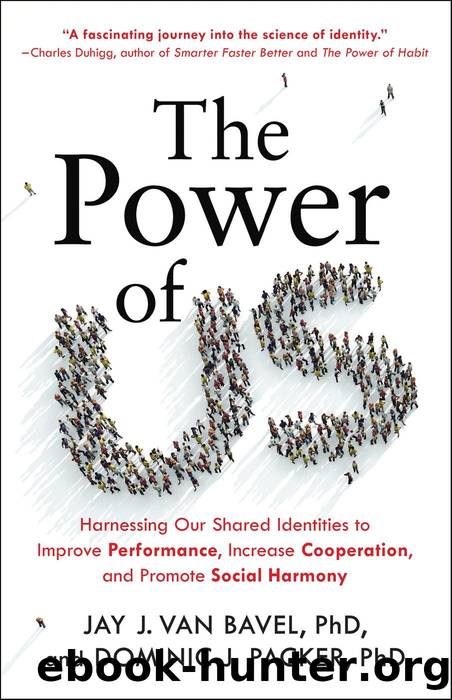The Power of Us: Harnessing Our Shared Identities to Improve Performance, Increase Cooperation, and Promote Social Harmony by Jay J. Van Bavel & Dominic J. Packer

Author:Jay J. Van Bavel & Dominic J. Packer [Bavel, Jay J. Van & Packer, Dominic J.]
Language: eng
Format: epub
Tags: Leadership, Psychology, None, Personality, Social Psychology, Cognitive Neuroscience & Cognitive Neuropsychology, Business & Economics
ISBN: 9780316538428
Google: RPAREAAAQBAJ
Publisher: Little, Brown
Published: 2021-09-07T00:23:16.801523+00:00
Wired for Social Identity
The two of us became interested in how identities affect implicit bias when we were sharing an office as graduate students. Around that time, there was a sense among many researchers that implicit racial biases were probably inevitable. It was assumed that after people were exposed for years to all of their societyâs stereotypes and prejudices, negative associations with marginalized groups would become deeply entrenched in their minds. Scholars found it difficult to reduce implicit bias in the lab, and measures of implicit bias were often quite disconnected from the explicit attitudes and values that people expressed in surveys or in public.
But we were curiousâjust how sticky were implicit racial biases? Could we override these biases by getting people to adopt a new, more inclusive identity?
To find out, we drove about a hundred and sixty miles from our office in Toronto to Kingston, Ontario, where Queenâs University had just built a new center for neuroscience and we were able to book the whole facility for large blocks of time. Wil Cunningham, our mentor, had to rent a car because his 1995 green Ford Escort did not have enough room for all of us (and none of us students could afford a car at that point). We lived out of a cheap hotel and spent our summer days in the basement of the brain center running participants through the functional neuroimaging scanner.
In previous brain-imaging studies, researchers had found that White participants consistently showed a pattern of racial bias in their neural responses when they saw people from different races. People who exhibited stronger implicit associations between Black and bad (as well as White and good) on the IAT showed greater blood flow in a small, almond-shaped region of the brain known as the amygdala.15 This relationship between implicit bias and brain activity was especially strong when subjects were presented with peopleâs faces for only a few millisecondsâless than the blink of an eye! This implied that the pattern of racial bias was happening very quickly in the brain and without their conscious awareness.16
At the time, the amygdala was widely believed to be centrally involved in the processing of negative emotions. However, our lab, as well as a few others, had begun to accumulate evidence that this brain area was perhaps better understood as reacting to highly relevant or important stimuli, from erotic images to famous celebrities. It seemed to be signaling something like Pay attention to this! Often, these signals were for negative or unfamiliar things, like out-groups. But positive things can be highly relevant and important too, especially when they are connected to our sense of identity.
The question we asked that summer was what would happen to brain activity in this region if participants felt a sense of shared identity with people of different races. This happens all the time at school, at work, and in sports, when people find themselves sharing groups and goals with people from any number of different backgrounds and ethnicities. We suspected
Download
This site does not store any files on its server. We only index and link to content provided by other sites. Please contact the content providers to delete copyright contents if any and email us, we'll remove relevant links or contents immediately.
Zero to IPO: Over $1 Trillion of Actionable Advice from the World's Most Successful Entrepreneurs by Frederic Kerrest(4303)
Machine Learning at Scale with H2O by Gregory Keys | David Whiting(4192)
Never by Ken Follett(3799)
Harry Potter and the Goblet Of Fire by J.K. Rowling(3776)
Ogilvy on Advertising by David Ogilvy(3516)
Shadow of Night by Deborah Harkness(3307)
The Man Who Died Twice by Richard Osman(2998)
Book of Life by Deborah Harkness(2869)
The Tipping Point by Malcolm Gladwell(2829)
Will by Will Smith(2795)
0041152001443424520 .pdf by Unknown(2785)
My Brilliant Friend by Elena Ferrante(2776)
How Proust Can Change Your Life by Alain De Botton(2746)
Purple Hibiscus by Chimamanda Ngozi Adichie(2653)
How to Pay Zero Taxes, 2018 by Jeff A. Schnepper(2602)
Hooked: A Dark, Contemporary Romance (Never After Series) by Emily McIntire(2502)
Rationality by Steven Pinker(2291)
Borders by unknow(2232)
Can't Hurt Me: Master Your Mind and Defy the Odds - Clean Edition by David Goggins(2230)
